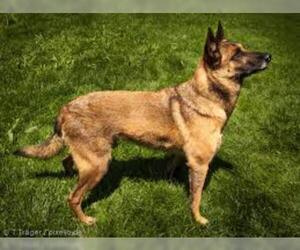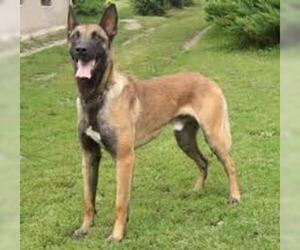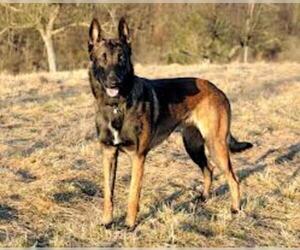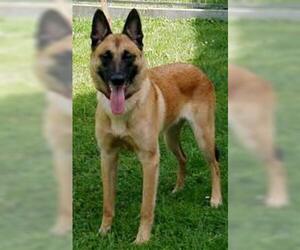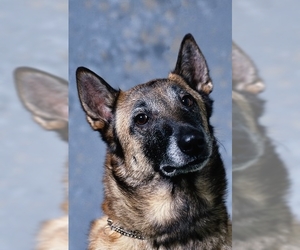
All about Belgian Malinois dog breed
A.K.A. :Malinois, Belgian Shepherd Malinois, Mali, Mal, Belgian Mal, BSD-Malinois, Mechelaar, Belgian Working Dog, Belgian Tracker, K9 Malinois, Tactical Mal, Euro Mal, Belgian Guard Dog, Maligator, M-Dog, Belgian Patrol Dog, Fawn Shepherd
Size
Grooming requirements
Exercise requirements
Good with other dogs
Watchdog ability
Energetic
Training requirements
Playful
Affectionate
Good with other pets
Good with children
Good with strangers
Winter
Summer
Healthiness
Protective
Life Span
| Pure Breeds | Member |
| Breeds A - Z | B |
| Breeds by Group | Herding |
| Breeds by Trait | Fast Dog Breeds High Stamina Dog Breeds Smartest Dog Breeds |
| Overview: | The Belgian Malinois is a highly intelligent and athletic breed, originating from Belgium as one of the four varieties of Belgian Shepherd dogs. Renowned for their striking appearance, they possess a short, weather-resistant coat, typically fawn to mahogany in color with a black mask. Physically, they are medium-sized, muscular, and agile, built for endurance and speed. Their temperament is characterized by high energy, trainability, and a strong protective instinct, making them excellent working dogs often employed in police and military roles. While devoted and affectionate with their families, their intensity and need for significant mental and physical stimulation mean they are generally not recommended for first-time dog owners or apartment living without a very dedicated owner. They thrive in active households that can provide consistent training, socialization, and ample space to exercise. Health-wise, they are a robust breed but can be prone to hip and elbow dysplasia, as well as certain eye conditions. |
F.A.Q.
All You Need to Know About the Belgian Malinois Breed
The Belgian Malinois is a highly intelligent and active herding dog originating from Belgium. Renowned for their exceptional work ethic and trainability, they possess a strong, athletic build with a short, weather-resistant fawn or mahogany coat, often with a black mask. Their temperament is typically confident, alert, and protective, making them excellent guard dogs and highly valued in police and military roles. While devoted to their families, Malinois require significant mental and physical stimulation; they are not suited for novice owners or apartment living due to their high energy levels and need for extensive exercise. Daily rigorous activity, like running or dog sports, is crucial. Grooming is minimal, primarily brushing a few times a week. Common health concerns include hip and elbow dysplasia. For active, experienced owners seeking a loyal and trainable companion, the Belgian Malinois is an unparalleled choice.Belgian Malinois Weight: Average Size & Healthy Weight
The average weight for a Belgian Malinois is typically between 40-80 pounds.* Males: Generally weigh more, ranging from 60-80 pounds.* Females: Tend to be lighter, usually between 40-60 pounds.This range represents a healthy weight for Belgian Malinois adults, reflecting their athletic and muscular build.Curious about the Belgian Malinois height? You've come to the right place! When considering a Malinois, understanding their average size is key to ensuring they're the right fit for your lifestyle.
The average height of a Belgian Malinois, measured at the shoulder (withers), typically ranges from 22 to 26 inches. This is a very athletic and medium-to-large breed, known for its agile build rather than sheer bulk.- Males: Generally, male Belgian Malinois are a bit taller and more substantial, typically standing between 24 and 26 inches.
- Females: Female Belgian Malinois usually fall into the 22 to 24-inch range.
Belgian Malinois Colors: A Comprehensive Guide to Coat TypesThe Belgian Malinois breed primarily comes in fawn with a black overlay and a black mask, a classic and highly recognizable combination. The fawn can range from a light tan to a rich mahogany. All major kennel clubs, including the AKC, recognize fawn with a black mask as the standard and only acceptable color. Red with a black overlay and mask is also common and falls within the acceptable fawn spectrum.While the AKC only accepts fawn, some reputable breeders may produce Malinois with rare coat types or exotic Belgian Malinois variations. These can include:* Sable: A darker version of fawn, where individual hairs are banded with black. Often seen as a more pronounced black overlay.* Mahogany: A deeper, richer reddish-brown fawn.* Cream: A very light fawn, almost off-white, often with a faint black mask.It's important to note that colors such as brindle, blue, lilac, merle, chocolate, and white are not officially recognized by the AKC or other major kennel clubs for the Belgian Malinois breed. While these exotic Belgian Malinois variations may exist due to recessive genes or cross-breeding, they are considered disqualifying faults in the show ring and often indicate a deviation from the breed standard. Potential adopters or buyers seeking a purebred Malinois should prioritize the standard fawn with a black mask to ensure adherence to breed health and temperament characteristics. Variations like blue or merle can sometimes be associated with health issues, making thorough research and breeder verification crucial. Pricing for rare coat types or exotic Belgian Malinois variations can vary significantly, but generally, a standard fawn Malinois from a reputable breeder will be the most common and often the most reliable choice.
The Belgian Malinois personality is characterized by high intelligence, intense loyalty, and a strong work ethic. These dogs are incredibly driven and thrive on having a job to do, making them highly trainable for various tasks. They are deeply devoted to their families, often forming a strong bond with one primary person. While generally not overtly friendly with strangers, a well-socialized Malinois is typically polite and observant rather than aggressive. Their high energy and need for mental stimulation make them less suitable for relaxed apartment living; they truly excel with a yard and an active lifestyle. With children, a well-trained Malinois can be gentle and protective, but due to their herding instincts and energy, supervision is always recommended, especially with very young children. Their high prey drive can make interactions with other small pets challenging without careful socialization from a young age. Early and consistent socialization is crucial for developing a well-adjusted and sociable temperament of Belgian Malinois.
Belgian Malinois Temperament & Personality TraitsThe Belgian Malinois is a highly intelligent, intensely loyal, and incredibly active breed known for its strong work ethic. They are not a breed for novice owners.Friendliness & Sociability: While devoted to their families, Belgian Malinois can be reserved with strangers. Early and consistent socialization is crucial to ensure they develop into well-adjusted adults. They are not typically a "friendly to everyone" type of dog, often preferring the company of their trusted few.Loyalty: Exceptional loyalty to their owner and family is a hallmark of the breed. They form deep bonds and are incredibly protective, making them excellent guardians.Adaptability to Apartment Living: Due to their very high energy levels and need for constant mental and physical stimulation, Belgian Malinois are generally not suited for apartment living. They thrive in homes with large, secure yards and owners committed to extensive daily exercise and training. Without adequate outlets, they can become destructive and anxious.Behavior with Children: With proper socialization and training, and when raised with children, they can be good family dogs. However, their herding instincts can sometimes manifest as nipping at heels or "corralling" children, so supervision is always recommended, especially with younger children. They are often better suited to families with older, more respectful children who understand how to interact with a high-drive dog.Behavior with Other Pets: When raised with other pets from a young age and properly socialized, a Malinois can coexist. However, their strong prey drive means careful introductions and ongoing supervision are essential, especially with smaller animals. They can be dominant with other dogs, particularly those of the same sex.Stubbornness & Sensitivity: While eager to please their owners, Malinois are also intelligent and can exhibit a degree of stubbornness, especially if they don't see the point of a command or if their needs aren't being met. They are generally sensitive to harsh corrections and respond best to positive reinforcement and consistent, firm but fair training. Their intense nature means they can be sensitive to their owner's mood and environment.In summary, the Belgian Malinois temperament is characterized by high drive, unwavering loyalty, and a need for a job. They are a magnificent breed for experienced owners who can provide the necessary training, socialization, and physical and mental exercise to channel their incredible energy and intelligence. They are not just companion dogs; they are partners.
Belgian Malinois care requires dedication. This is not a low-energy dog breed. They need extensive daily exercise and mental stimulation; think working dog, not couch potato. Without it, expect destructive behaviors.
Grooming needs are moderate. A short, dense coat requires weekly brushing to manage shedding. How to care for a Belgian Malinois coat involves occasional bathing. Wrinkle and ear cleaning are not typically a concern as they don't have deep facial folds or pendulous ears. Dietary considerations involve high-quality dog food appropriate for their high energy levels and life stage. Monitor portions carefully for weight management, as obesity can exacerbate joint issues. Regarding climate sensitivity, the Belgian Malinois is generally tolerant of various climates but can overheat in extreme summer heat due to their double coat. Always provide shade and fresh water. They are NOT brachycephalic, so breathing issues related to that anatomy are not a concern.Common health tips for Belgian Malinois include regular veterinary check-ups. They are prone to hip and elbow dysplasia. Dental care is crucial; daily brushing helps prevent periodontal disease. While generally healthy, monitor for skin issues and allergies. Early socialization and consistent training are vital for their well-being. This breed thrives with an experienced owner committed to their specific needs.The Belgian Malinois activity level is extremely high, requiring significant daily exercise. They are not brachycephalic; their long snouts allow for excellent stamina. Expect long, vigorous walks, runs, or mentally stimulating activities like agility and obedience training. They thrive on having a job to do and are known for their intense drive and focus during playtime. While they can balance short bursts of intense energy with periods of calm rest, this "rest" often means watchful alertness. How active are Belgian Malinois? Very. They are ideally suited for highly active families committed to daily, structured exercise and mental engagement. They are unsuitable for low-energy households or those seeking a casual companion. Their exercise needs are non-negotiable for a well-adjusted dog.
Breed Breakdown: What Experts Say About the Belgian Malinois
I would rate the "Size" trait of the Belgian Malinois as a 7.Belgian Malinois are a medium to large-sized breed. Males typically stand 24-26 inches tall at the shoulder and weigh 60-80 pounds, while females are slightly smaller at 22-24 inches and 40-60 pounds. They possess a lean, muscular, and athletic build, giving them a substantial presence without being overly bulky. When compared to other companion dogs, they are clearly larger than breeds like Beagles, Terriers, and many Spaniels, but not as massive as Great Danes, Mastiffs, or Saint Bernards. Their size, combined with their high energy levels, makes them generally not well-suited for apartment living or households with significant space constraints. While they can certainly travel, their size and intense drive mean they require more dedicated space and management than a smaller dog, making them a better fit for homes with a yard and active owners.
I would rate the Belgian Malinois's grooming requirements as a 3.While they have a double coat that does shed seasonally, particularly heavily twice a year, their overall grooming needs are quite low-maintenance compared to many other companion dogs. Their short, dense coat doesn't mat easily and generally requires only weekly brushing to remove loose hair and keep it healthy, with more frequent brushing during shedding seasons. They don't have skin folds that require special cleaning, and their ears are typically erect and less prone to trapping moisture, needing only routine checks and occasional cleaning. Nail trimming is standard for any dog, and bathing is only necessary when they get particularly dirty, as over-bathing can strip their natural oils. They are not known to be overly susceptible to skin issues or allergies more than the average dog. Their easy-care coat and lack of specialized needs make them a relatively straightforward breed to groom.
I would rate the Belgian Malinois's exercise requirements as a 10.The Belgian Malinois is an extremely high-energy breed, originally bred for demanding work as a herding and protection dog. They have an almost endless well of stamina and thrive on sustained, vigorous activity. Daily walks, even long ones, are generally insufficient to meet their physical and mental needs. They require structured routines that include a significant amount of intense physical exercise, such as running, swimming, advanced obedience, agility, flyball, or bite work. Their tolerance for sustained movement is exceptional, and they are capable of working for extended periods without tiring. Unlike brachycephalic breeds, they do not have respiratory limitations that would hinder intense exercise. Without adequate physical and mental stimulation, Malinois are prone to destructive behaviors, anxiety, and developing obsessive tendencies. They truly demand a lifestyle that involves consistent, challenging activity to remain healthy, well-adjusted, and mentally stimulated. They are not a breed that can thrive with minimal activity; they absolutely require an owner committed to providing an outlet for their immense drive.
I would rate the Belgian Malinois's "Watchdog Ability" at a 9.The Malinois is an exceptionally alert and vigilant breed, constantly aware of its surroundings. They are quick to react to unfamiliar sounds, sights, or people, and their barking behavior is typically assertive and purposeful when something is amiss. Their strong territorial instincts mean they will readily perceive and address perceived threats to their home and family. While not inherently aggressive without cause, their imposing presence, confident demeanor, and willingness to deter intruders make them highly effective at providing meaningful early warnings and a strong deterrent in a home environment. They are far from a passive companion; they are active and engaged protectors.
I would rate the "Good with Other Dogs" trait of the Belgian Malinois at a 5.Belgian Malinois are highly intelligent, driven, and possess a strong prey drive, often accompanied by a natural tendency towards guarding and protective behaviors. While not inherently aggressive towards other dogs, their intense nature and high energy can manifest as a lack of patience or tolerance for other dogs, especially those that don't match their energy level or respect their personal space. They often require extensive and consistent socialization from a young age to develop appropriate canine social skills. Without this, they can be prone to dominance displays or reactivity towards unfamiliar dogs. In a multi-dog household, they can thrive with careful introductions and clear hierarchy, especially if the other dogs are well-matched in energy and temperament, and the Malinois is adequately exercised and mentally stimulated. However, they are not a breed that typically falls into the "go-with-the-flow" category when it comes to canine companionship; rather, they require thoughtful management and training to ensure peaceful coexistence, especially with dogs of varying sizes and energy levels. They don't typically exhibit the inherent sociability of breeds like Golden Retrievers or Labradors.
I'd rate the "Energetic" trait of the Belgian Malinois as a 10.The Belgian Malinois is an exceptionally high-energy breed, almost unparalleled among companion dogs. Their typical activity level is ceaseless; they are constantly "on" and looking for a job or an outlet for their energy. Their endurance is phenomenal, allowing them to work or play for extended periods without tiring, which is why they excel in police, military, and various dog sports. Playfulness in a Malinois often manifests as intense, driven engagement, and they require a tremendous amount of physical stimulation to remain well-adjusted. They are absolutely built for and thrive on participating in demanding outdoor and athletic activities such as agility, protection sports, obedience, and tracking. Compared to most other companion dogs, the Malinois is unequivocally naturally active and incredibly driven, making virtually all other breeds seem laid-back in comparison. It's important to note that the Belgian Malinois is not a brachycephalic breed; it possesses a normal, well-proportioned muzzle, which contributes significantly to its excellent stamina and exercise tolerance, allowing it to breathe efficiently even during strenuous activity.
I would rate the Belgian Malinois's "Training Requirements" at an 8.5.While their intelligence and high drive make them incredibly capable of learning complex commands and tasks, they are far from "easy" to train. Their boundless energy and intense focus, if not properly directed, can lead to destructive behaviors or an inability to settle. They possess a high degree of "drive" which can manifest as relentless pursuit of a task, but also as a tendency to push boundaries if leadership isn't clear and consistent. Stubbornness isn't a primary characteristic in the way it might be for some scent hounds, but rather a strong will to achieve their own objectives if a handler isn't effectively communicating and leading.They have excellent attention spans when engaged in a task and are highly responsive to commands, but this requires an equally high level of engagement and consistency from the trainer. Positive reinforcement is highly effective, but must be paired with clear expectations, firm boundaries, and a structured routine from a very young age. This breed is absolutely not beginner-friendly. They require an experienced, confident, and dedicated handler who understands their unique working dog temperament and is prepared to invest significant time and effort into their ongoing training, socialization, and mental stimulation throughout their lives. Without a structured routine and experienced handling, a Malinois can quickly become overwhelming and difficult to manage.
I would rate the Belgian Malinois's "Playful" trait a solid 9 out of 10.Belgian Malinois are not just energetic; they are intensely interactive and possess a profound love for "work" which, to them, often translates into highly engaging play. Their typical activity level is exceptionally high, and they thrive on games and structured interaction. These dogs are inherently driven, and that drive often manifests as an enthusiastic pursuit of toys, balls, and any activity that involves their human. They can be quite attention-seeking when they want to initiate play or mental stimulation, often nudging or "talking" to their owners. Their response to toys is usually immediate and passionate, making them ideal partners for sports like obedience, agility, and bite work, which are essentially highly structured forms of play. Their overall enthusiasm in daily life is palpable; they are rarely just "chilling out" for extended periods unless they are truly exhausted from mental and physical exertion. Compared to many other companion dogs, the Malinois is far from laid-back; they are naturally spirited and require significant outlets for their inherent zest for life and desire to engage.
I would rate the Belgian Malinois's "Affectionate" trait a 6.While incredibly loyal and devoted to their families, the Malinois isn't typically known for being overtly cuddly or a "lap dog" in the same way some other companion breeds are. Their affection often manifests through their unwavering presence, intense focus on their owner, and desire to be involved in whatever the family is doing. They are certainly people-oriented and thrive on human companionship, often following their chosen person from room to room. They are also quite sensitive to their owner's emotions and will respond to changes in mood. However, their physical affection tends to be less about extended snuggling and more about a close proximity, a lean, or an occasional lick. They are affectionate in their own intense, dedicated way, but it’s a working affection, seeking to be near and involved rather than purely for physical comfort. They are more independent in their expression of affection compared to breeds that are constantly seeking physical contact, but still deeply attached and loving.
I would rate the Belgian Malinois's "Good with Other Pets" trait a 4 out of 10.While not inherently aggressive, the Malinois's intense prey drive, strong guarding instincts, and need for a job can make them highly challenging in multi-pet households, particularly with smaller animals like cats or even some smaller dog breeds. They are not naturally sociable with other pets in the way some breeds are; instead, successful coexistence almost always requires extensive, early, and ongoing socialization, strict training, and constant supervision. Their high energy and desire to herd or chase can easily overwhelm other animals, and resource guarding can become a significant issue if not proactively managed. Adaptability in a multi-pet household is low without significant human intervention, and even then, some level of management will likely always be necessary.
The Belgian Malinois rates a 3 out of 10 for the "Good with Children" trait. This breed is generally not well-suited for families with children, especially young ones. Their temperament is characterized by high energy, intense prey drive, and a strong protective instinct, all of which can be problematic around children. Malinois are bred for working roles and thrive on a structured environment with clear leadership. Their play can be rough and their herding instincts might lead to nipping at children's heels. They have a low tolerance for the unpredictable movements, loud noises, and often clumsy handling that comes with children, potentially leading to stress or reactivity. While they can be affectionate with their trusted family members, this affection isn't typically expressed in a naturally gentle or patient way that is ideal for kids. They require extensive socialization, consistent training, and constant, diligent supervision to even coexist safely with children, rather than being naturally compatible. They are not naturally gentle or overtly affectionate in a way that benefits children and their high drive means they need an "off switch" that can be difficult to implement around the stimulating environment children create.
I would rate the Belgian Malinois's "Good with Strangers" trait as a 3 out of 10.Belgian Malinois are not naturally outgoing or overtly friendly with strangers. Their strong protective instincts and inherent wariness mean they are typically reserved, watchful, and can be aloof or even suspicious around unfamiliar adults. They are bred to be guardians and working dogs, not social butterflies. While proper socialization from a young age is crucial and can help them tolerate or be neutral towards strangers, it rarely makes them genuinely welcoming or demonstrative. They are highly likely to bark at, observe intently, or subtly position themselves between their handler and an unfamiliar person. Their adaptability in public or guest-filled environments depends heavily on their training and the specific situation; they are constantly assessing their surroundings for potential threats. They require extensive, consistent training and socialization to be merely comfortable, rather than naturally at ease, with strangers.
The Belgian Malinois would rate around a 6 for winter tolerance. While they possess a dense double coat that offers good insulation, their lean body mass and lack of significant body fat make them more susceptible to cold than some other northern breeds. Their medium size is a neutral factor, and they are not brachycephalic, so breathing in cold air isn't an inherent issue. They can certainly enjoy outdoor activities in cold climates, but prolonged exposure in very low temperatures, especially with wind or precipitation, significantly increases their risk of hypothermia. Compared to many companion dogs, their active nature and double coat provide a better baseline for cold, but they will still require special care during winter months, such as monitoring for shivering, limiting time outdoors in extreme cold, and potentially needing a coat for extended periods outside or in frigid conditions, especially if they are not actively exercising. They are built for movement and work, and without that activity, their internal furnace might struggle to keep up in harsh winter environments.
I would rate the Belgian Malinois's "Summer" tolerance at a 4. While not as extreme as a true brachycephalic breed, they are still a medium-to-large, active dog with a dense, double coat. Their athleticism and drive mean they can easily overexert themselves in hot weather, quickly leading to overheating. They are not brachycephalic, which is a positive factor, but their strong desire to work and play can override their natural instincts to rest in the heat. They struggle to regulate body temperature effectively when ambient temperatures rise, and their risk of heatstroke is significant without proper management. Compared to many other companion dogs, especially those with lighter coats or less activity drive, the Malinois absolutely requires special care in summer months. This includes strict limitations on outdoor activity during the hottest parts of the day, ensuring constant access to cool water and shade, and often requiring air-conditioned indoor environments during peak summer heat to prevent heat-related illnesses. They cannot be left unsupervised outdoors for extended periods in warm weather.
I would rate the Belgian Malinois's "Healthiness" trait as an 8 out of 10.The Belgian Malinois is generally considered a robust and healthy breed, particularly when compared to many other companion dogs that have been bred for exaggerated physical traits. Their working dog heritage has prioritized functionality and resilience, contributing to fewer breed-specific health issues compared to some breeds. They boast a relatively good life expectancy of 12-14 years.However, like all purebred dogs, they do have some genetic predispositions. The most notable concerns are joint problems, primarily hip and elbow dysplasia, which can be mitigated significantly through responsible breeding practices that include health clearances of parent dogs. They can also be prone to certain eye conditions and, less commonly, some forms of cancer or epilepsy. While not typically high-maintenance in terms of needing extensive medical intervention for chronic conditions, their high energy levels and need for mental stimulation do require proactive care to prevent behavioral issues that can manifest as stress-related physical problems. With responsible breeding and diligent preventive care, including proper nutrition, exercise, and regular veterinary check-ups, a Malinois can lead a long and very healthy life.
I would rate the "Protective" trait of the Belgian Malinois at a 9.5 out of 10.Belgian Malinois are exceptionally protective, bordering on legendary for this quality. Their inherent alertness is astounding; they are constantly aware of their surroundings and quick to notice anything out of the ordinary. This high level of vigilance fuels strong territorial instincts, and they will readily perceive any unfamiliar presence on their property as a potential threat. Their loyalty to their owners is unwavering and profound, forming an intense bond that drives their protective nature. When it comes to strangers, a Malinois is typically aloof and wary, not openly aggressive unless provoked or if they perceive a threat to their family, but always observing. They are outstanding watchdogs, with their sharp barks effectively alerting to intrusions, and their imposing presence combined with their intelligence and athleticism makes them incredibly capable guard dogs. While they are deeply loyal and affectionate with their immediate family, they are absolutely not just companion dogs; they are serious working dogs that, when properly trained and socialized, are fully capable of offering meaningful and significant protection in a household setting, often performing at a professional level in protective roles.
I would rate the Belgian Malinois's "Life Span" trait a 7 out of 10.The Belgian Malinois is generally considered a long-lived breed compared to many other medium to large companion dogs. Their average life expectancy typically ranges from 10 to 14 years, with many individuals exceeding that range when provided with excellent care. While they are a relatively robust and healthy breed, they are not entirely free from common health issues. They can be genetically predisposed to hip and elbow dysplasia, as well as certain eye conditions and epilepsy, though reputable breeding practices significantly reduce the incidence of these problems. Their athletic build and high energy also mean they are prone to injuries if not properly conditioned and managed. However, responsible breeding for sound structure and temperament, combined with a high-quality diet, ample exercise, and regular veterinary check-ups, contributes significantly to their ability to live long, active lives. They are not as long-lived as some smaller breeds, but they certainly outlive many larger breeds prone to more significant health challenges.
Belgian Malinois Puppies for saleSee all puppies for sale
Belgian Malinois Dogs for adoptionSee all dogs for adoption
Belgian Malinois BreedersSee all breeders
Similar Dog Breeds for Belgian Malinois
Breed Mixes of Belgian Malinois
Quick Breed Selector 0 - not important, 1 - smallest, 10 - largest
Variants & Mistakes :Belgian Malinose, Belgian Malanois, Belgian Malinoisx, Belgian Malionois, Belgian Malanoise, Belgian Malinoisd, Begian Malinois, Beligian Malinois, Belgain Malinois, Beligan Malinois, Belgin Malinois, Beljian Malinois, Belgiun Malinois, Beligian Malinose, Belgain Malinose, Beligan Malinose, Belgin Malinose, Beljian Malinose, Belgiun Malinose, Malinois, Malanois, Malinose, Malinoise, Malinoy, Malinowy, Malanoise, Malionois, Malinoys, Malinoi, Belgian Malinoise, Malinois-Belgian, Belinois, Bellinois, Malinoa, Malanois-Belgian, Malinois Belgian, Mal
